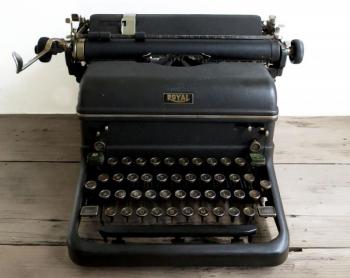What’s the Buzz? Rest in Peace, Typewriter?
My father had a study in the Church where he was Pastor. Two of the walls were bookshelves, floor to ceiling filled with ancient books and artifacts. There was a piece of the Charter Oak, there was a fossil of a fern, thousands of years old, and a small marble bust of someone or other.
As you entered the doorway, the smell of leather chairs and books, and the safe shade of centuries of learning greeted you. It was dark, or seemed so, in spite of the facing window, a safe kind of dark with an engulfing sense of comfort.
Directly in front there was a big wooden glass topped desk with carved drawer pulls, which is now in my rather pedestrian apartment.
As a little girl, I loved to go in to this sanctum sanctorum where my father wrote stories and sermons. The brown leather desk chair was molded into his shape and when I climbed on it, I was allowed to touch the Royal.
The typewriter was centered on the desk accompanied only by piles of paper with inky words, scraps of articles and one box camera.
Father Busby allowed us to type on the Royal, whenever we wanted. Hours were spent in solitude there from the active Parsonage across the driveway, and creativity was born in me.
Before I could hunt and peck on my own, I dictated to Pa, as only I called him, and he proudly shared my ’ brilliant’ stories and poems with my mother. I can’t recall what she thought or said she was busy with being the Preacher’s wife, with a household of teenagers and children.
The day came when I sat in the big chair all alone. I struck a key, and struck was the proper word, it took pressure and the resounding smack of key on paper was addictive. Each keystroke was forever, and the only way to erase an error was to strike it out ###. Ribbons tangled, were sorted out, fingers stained and papers smeared.
We used a half sheet of paper, this was how it was cut so that the sheets were not obtrusive on the podium on Sunday when Pa read, or referred to, his sermons. I learned to write on that Royal
Pages and pages and pages, many with strike-outs, term papers that had to be just so, requiring restarts again and again, business letters that were frustratingly hard to line up with the margins , all came from those machines.
My sister learned to type on that Royal, although she learned to do it properly, not all over the place with eyes on the keys as I did. (still do.) She could type so fast and so correctly that it made my head swim. They counted words per minute as a mark of expertise, back then. No spell check, no auto-correct, no erase a line without a trace. It had to be right.
Today the last factory, making the last typewriter, in the entire world has been closed up. For a few years there will be repair shops where inky ribbons, sticky keys and rollers to line up paper are still fixed. They will die off, too.*
The clickety-clack of the key on paper, the satisfaction of pulling that finished page from the roller, the absolute knowledge that you had to sit at a desk to write, will soon be gone forever.
The typewriter is leaving us but the laptop is here. Now we can take our work everywhere, and we do. Now we can’t shut the study door and carry away our typed work proudly in our hands. Now we don’t sit in the same chairs where our fathers wrote and look out the same windows. Everyone can write, and does, on a computer. It’s good.
Still, the inky fingers, the laughter over the tangled ribbons, the reams of paper, and the security of click click click , which is quite different from the ‘click here’ of today, will be missed.
*Note: “The typewriter is "far from dead," [says] Ed Michael, General Manager of Sales at New Jersey-based Swintec. “There are manufacturers making typewriters in China, Japan, Indonesia, "We have contracts with correctional facilities in 43 states to supply clear typewriters for inmates so they can't hide contraband inside them," Michael explained.
There you have it: So long as you can smuggle a nail file inside a netbook, the typewriter will live to jam another day.

































.png)
.png)
